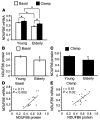Genetic and epigenetic factors are associated with expression of respiratory chain component NDUFB6 in human skeletal muscle
- PMID: 17948130
- PMCID: PMC2030455
- DOI: 10.1172/JCI30938
Genetic and epigenetic factors are associated with expression of respiratory chain component NDUFB6 in human skeletal muscle
Abstract
Insulin resistance and type 2 diabetes are associated with decreased expression of genes that regulate oxidative phosphorylation in skeletal muscle. To determine whether this defect might be inherited or acquired, we investigated the association of genetic, epigenetic, and nongenetic factors with expression of NDUFB6, a component of the respiratory chain that is decreased in muscle from diabetic patients. Expression of NDUFB6 was influenced by age, with lower gene expression in muscle of elderly subjects. Heritability of NDUFB6 expression in muscle was estimated to be approximately 60% in twins. A polymorphism in the NDUFB6 promoter region that creates a possible DNA methylation site (rs629566, A/G) was associated with a decline in muscle NDUFB6 expression with age. Although young subjects with the rs629566 G/G genotype exhibited higher muscle NDUFB6 expression, this genotype was associated with reduced expression in elderly subjects. This was subsequently explained by the finding of increased DNA methylation in the promoter of elderly, but not young, subjects carrying the rs629566 G/G genotype. Furthermore, the degree of DNA methylation correlated negatively with muscle NDUFB6 expression, which in turn was associated with insulin sensitivity. Our results demonstrate that genetic, epigenetic, and nongenetic factors associate with NDUFB6 expression in human muscle and suggest that genetic and epigenetic factors may interact to increase age-dependent susceptibility to insulin resistance.
Figures



References
-
- Mootha V.K., et al. PGC-1alpha-responsive genes involved in oxidative phosphorylation are coordinately downregulated in human diabetes. Nat. Genet. 2003;34:267–273. - PubMed

